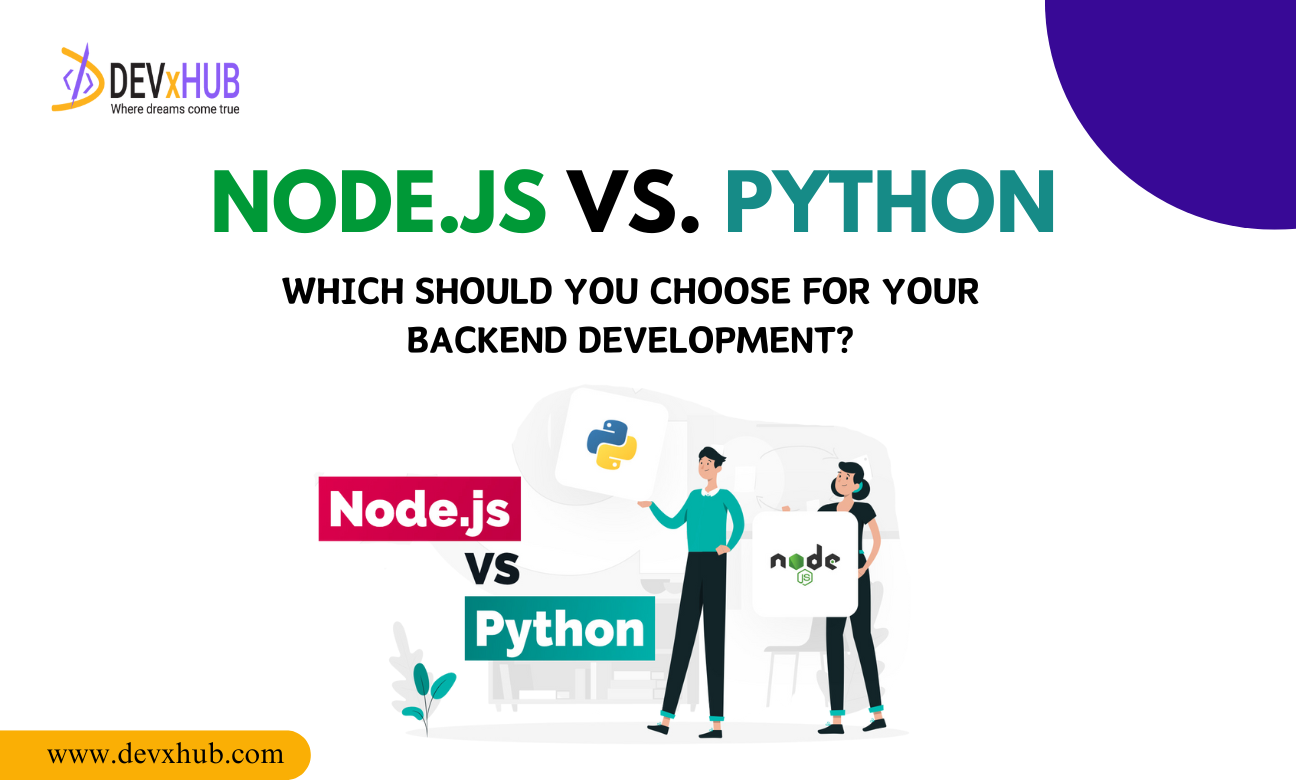Blog - Node.js vs. Python: Which Should You Choose for Your Backend Development?
The server-side or backend of any application forms the core foundation of your project. It’s the backbone that supports the client-side, user-facing elements of a web application. Selecting the right backend technology can be a game-changer for building high-performance applications. This post compares two of the most popular backend technologies, Node.js and Python, to help you make an informed choice for your project.
Let’s dive in!
What is Node.js?
Node.js is an open-source JavaScript runtime environment that runs on Chrome’s V8 engine, allowing code to execute outside the client’s browser. It’s designed to be cross-platform and event-driven, making it ideal for building fast and scalable network applications. Developers often use Node.js for server-side programming and non-blocking I/O operations.
What is Python?
Python is a high-level, interpreted programming language known for its simplicity and versatility. It’s widely used in backend development, following an object-oriented approach. Python’s features like dynamic typing, built-in data structures, and dynamic binding make it an excellent choice for rapid application development (RAD). It’s also frequently used as a scripting language to connect existing components.
Comparing Use Cases: Node.js vs. Python
Understanding the strengths and weaknesses of Node.js and Python in different scenarios can help you choose the right technology for your project.
Top Node.js Use Cases:
- Real-Time Applications: Node.js is ideal for building real-time applications like chat apps, collaborative tools, and live streaming platforms due to its event-driven architecture and non-blocking I/O.
- Single-Page Applications (SPAs): Node.js is well-suited for SPAs that require asynchronous data loading, as it can handle multiple operations simultaneously without affecting performance.
- Microservices Architecture: Node.js allows developers to create a microservices architecture, where different services are built and deployed independently, enabling better scalability and maintainability.
- IoT Implementations: Node.js is commonly used in IoT applications for managing real-time data and device communications, thanks to its ability to handle multiple concurrent connections efficiently.
- Data Streaming Applications: Node.js excels in building data streaming applications like Netflix, where data needs to be processed in chunks rather than waiting for the entire data to be available.
Top Python Use Cases:
- Web Development: Python, with its frameworks like Django and Flask, is a powerful choice for backend development. Its clear syntax and readability make it easy to build and maintain large web applications.
- Data Science and Machine Learning: Python is the go-to language for data science, machine learning, and AI projects. Libraries like TensorFlow, PyTorch, and scikit-learn make it easy to build and deploy models.
- Automation and Scripting: Python’s simplicity and versatility make it perfect for automating repetitive tasks, scripting, and integrating different software components.
- IoT Projects: Python is also used in IoT projects, especially when combined with libraries like MicroPython and CircuitPython, which are optimized for microcontrollers.
- Data Visualization and Image Processing: Python’s libraries such as Matplotlib, Seaborn, and OpenCV are widely used for data visualization, image processing, and creating complex visualizations for data analysis.
Node.js vs. Python: In-Depth Comparison
To help you further, let’s explore several critical aspects of these technologies.
1. Learning Curve and Syntax
- Python: Python’s syntax is clear and straightforward, often described as close to natural language. It requires fewer lines of code compared to other languages, which simplifies debugging and maintenance. Python is an excellent choice for beginners and for projects that need rapid development.
- Node.js: Node.js uses JavaScript syntax, which may be familiar to web developers. If you already have experience with JavaScript, transitioning to Node.js can be relatively easy. However, its asynchronous nature can introduce complexity, especially when handling callbacks and promises.
2. Architecture
- Node.js: Node.js is built on an event-driven, non-blocking architecture, allowing it to handle multiple requests simultaneously without waiting for tasks to complete. This makes it highly suitable for applications requiring real-time interactions, such as chat applications, online games, or live video streaming.
- Python: Python typically follows a synchronous, blocking architecture, which can slow down performance, especially for I/O-bound tasks. However, Python can achieve concurrency using libraries like Asyncio, and projects requiring parallel processing can benefit from CPython.
3. Libraries and Package Management
- Python: Python’s package manager, Pip, provides access to over 220,000 packages covering various categories like data science, machine learning, web development, and more. This vast ecosystem makes Python highly versatile and adaptable to different projects.
- Node.js: Node.js uses npm (Node Package Manager), which is one of the largest repositories of packages with over 1.3 million libraries. The extensive range of packages available in npm allows developers to quickly find and integrate solutions for various needs, from database management to UI frameworks.
4. Speed and Performance
- Node.js: Node.js excels in performance due to its non-blocking I/O operations and ability to execute code outside the browser. This results in faster execution times, especially for applications requiring real-time data processing or streaming. Node.js also supports caching, reducing the time it takes to fetch data and improving overall application responsiveness.
- Python: Python is generally slower than Node.js because it does not support multithreading natively and operates as a single-threaded language with a global interpreter lock (GIL). This makes Python less suitable for performance-critical applications, especially those requiring high concurrency or frequent server interactions.
5. Scalability
- Node.js: Node.js is highly scalable, supporting multithreading and offering a cluster module to fully utilize the processing power of the machine. Developers can scale Node.js applications both vertically (by adding more resources) and horizontally (by adding more nodes to the system), making it a preferred choice for large-scale applications.
- Python: Python is less scalable due to its single-threaded nature and reliance on the GIL. While Python can be scaled, it typically requires more effort and may not perform as efficiently as Node.js in highly concurrent environments.
6. Error Handling
- Python: Python’s clear syntax and readability make error handling straightforward. The language’s concise code reduces the chance of errors and simplifies debugging, making it easier to maintain clean and reusable code.
- Node.js: While Node.js offers robust error-handling mechanisms, debugging can become complex in environments with multiple concurrent processes. The asynchronous nature of Node.js can make it challenging to trace errors across different callbacks and promises.
7. Extensibility
- Python: Python is highly extensible, with numerous frameworks like Django, Flask, and CherryPy that add functionality to the language. These frameworks, along with a wide range of APIs, allow developers to extend Python’s capabilities according to their project needs.
- Node.js: Node.js is equally extensible, with built-in APIs and frameworks such as Express, Hapi, and Fastify that allow developers to build highly functional applications. Node.js also supports various testing frameworks, like Jasmine and Mocha, for building robust and reliable applications.
8. Community Support
- Python: Python has a large and active community with extensive resources available online. The Python community is known for its collaborative spirit, and developers can easily find support through forums, tutorials, and documentation.
- Node.js: Node.js also benefits from a strong community, particularly among web developers. The npm ecosystem is constantly growing, with contributors from around the world adding new packages and updates, making it easy for developers to find solutions and support.
When to Choose Node.js
- Real-time applications like messengers and chatbots
- Complex single-page applications (SPA)
- IoT implementations
- Collaboration tools and systems
- Data streaming applications
- Microservices architecture
- Online eCommerce and gaming platforms
When to Avoid Node.js
- Projects requiring heavy computations
- CRUD or HTML applications
- Backend apps with relational databases
- Multi-threaded programming projects
When to Choose Python
- Progressive web applications (PWAs)
- IoT projects
- Data visualization and image processing
- AI/ML and Neural Networks
- Voice and facial recognition
- Startups, Fintech, Finance
- Data Science and Engineering
When to Avoid Python
- Mobile app development (Not supported by iOS and Android)
- Game development (High memory consumption)
- Projects requiring interaction with complex legacy data
Conclusion
Choosing between Node.js and Python depends on the specific requirements and goals of your project. Node.js offers speed, scalability, and real-time capabilities, making it ideal for I/O-heavy and real-time applications. On the other hand, Python shines in areas that require complex computations, data analysis, and where development speed and simplicity are critical.
Ultimately, both Node.js and Python are powerful backend technologies that can support a wide range of applications. By understanding the strengths and limitations of each, you can make an informed decision that aligns with your project’s needs, ensuring the success and longevity of your application.
Related Posts
Categories
- App Development (2)
- Design (2)
- DEVxHUB (30)
- Digital Marketing (2)
- Guide (24)
- It Bangladesh (1)
- Logo design (1)
- Operating system (1)
- Personal Improvement (14)
- Planning (4)
- Project management (3)
- Social media (2)
- Software Development (5)
- Software Quality Assurance (8)
- Startups (1)
- Team work (1)
- UI UX (1)
- Web Development (6)
Main Tags
- 2024
- Android
- app development
- bangladesh
- content writing
- design
- devxhub
- Digital marketing
- Guide
- IOS
- It
- logo design
- Operating system
- Personal Improvement
- planning
- project management
- social media
- Software Development
- Software Quality Assurance
- software testing
- software testing types
- Startups
- Success
- team
- UI UX
- UI UX design
- VR
- Web Development















